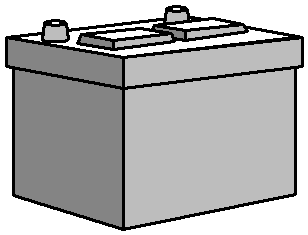 |
| ||||||
BatteriesWhat is a battery?The word battery means a collection, as in Gun Battery. An electric battery consists of two or more Galvanic cells. A Galvanic cell is an electrochemical system that transforms chemical energy into electric energy. Such a cell in speaking terms is called a battery. A battery’s purpose is to store energy and when needed release this energy in the form of electric energy. The amount of energy a battery can release is synonymous with its capacity. The term energy is rated in joule (j). However, electrical energy is often represented in Wh (Watt Hours). As a battery’s voltage is somewhat constant its capacity is a function of current × time (Ah).
Non-chargeable batteries are called primary batteries. Batteries used in an ordinary flashlight are usually primary batteries. Rechargeable batteries are called secondary batteries and consist of electrolytic cells capable in generating chemical energy into electrical energy. An ordinary car battery is a secondary battery also called accumulator. A Fuel cell is not a galvanic cell. However, it is constructed in a similar way and can generate electric current. A fuel cell transforms hydrogen and oxygen gas into water. This reaction generates 0.7 Volt. A battery can consist of a group of batteries. An example is a battery in an UPS that contains 32 serial connected 12 Volt batteries each including 6 cells of lead-acid type. Each cell generates 2 Volt resulting in a 36*6*2=384 Volt battery. Our 12 Volt battery in the example above is sometimes referred to as a battery block or simply a block. While a battery’s total voltage is the sum of each individual cell’s voltage its current is limited to that of the weakest cell. Therefore, if a short circuit in one 2 Volt cell total voltage would fall from 384V to 382V i.e. only 0.5%. Yet, total capacity falls to the same level.
Reliability and life cycle.In each cell there is an ongoing chemical process. Some of these processes are necessary while others are harmful resulting in a decrease of the cell's capacity. Chemical reactions in a cell are affected by internal factors such as impurities in the electrolyte and external factors such as recharge voltage, recharge current, temperature and humidity. Furthermore, a cell’s aging process is affected by historical facts such as numbers and characteristics of recharge and discharge. After a period of time some cells will be deteriorated.
Common symptoms in failing batteries
The Car Battery FAQ http://www.batteryfaq.org/ |


